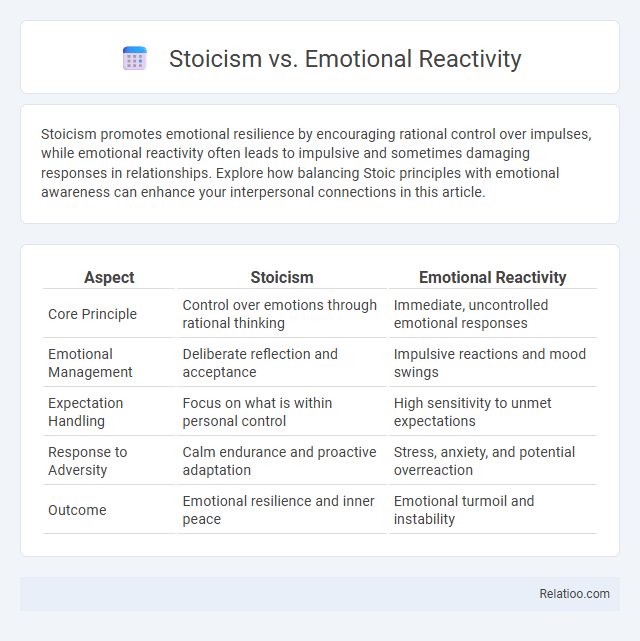Stoicism promotes emotional resilience by encouraging rational control over impulses, while emotional reactivity often leads to impulsive and sometimes damaging responses in relationships. Explore how balancing Stoic principles with emotional awareness can enhance your interpersonal connections in this article.
Table of Comparison
| Aspect | Stoicism | Emotional Reactivity |
|---|---|---|
| Core Principle | Control over emotions through rational thinking | Immediate, uncontrolled emotional responses |
| Emotional Management | Deliberate reflection and acceptance | Impulsive reactions and mood swings |
| Expectation Handling | Focus on what is within personal control | High sensitivity to unmet expectations |
| Response to Adversity | Calm endurance and proactive adaptation | Stress, anxiety, and potential overreaction |
| Outcome | Emotional resilience and inner peace | Emotional turmoil and instability |
Understanding Stoicism: Core Principles
Stoicism emphasizes rational control over emotions, teaching individuals to distinguish between what is within their control and what is not, thereby promoting inner tranquility. This philosophy advocates for emotional resilience by cultivating virtues such as wisdom, courage, and self-discipline to respond thoughtfully rather than react impulsively. Unlike fleeting emotional reactivity driven by temperament, Stoicism encourages a deliberate mindset that transforms emotional challenges into opportunities for personal growth.
Defining Emotional Reactivity
Emotional reactivity refers to the intensity and immediacy of your emotional responses to stimuli, often characterized by spontaneous and strong feelings that can influence behavior. Unlike Stoicism, which emphasizes rational control and emotional regulation to maintain inner calm, emotional reactivity involves less filtering of emotions before they manifest. Temperament plays a foundational role in how prone you are to emotional reactivity, with some individuals naturally experiencing more vivid emotional responses based on biological factors.
Historical Roots: Stoicism vs. Modern Emotional Responses
Stoicism, rooted in ancient Greek and Roman philosophy, emphasizes rational control over emotions to achieve tranquility and resilience, contrasting sharply with modern emotional reactivity driven by immediate, often unconscious responses shaped by temperament. Your understanding of these historical foundations can help bridge the gap between Stoic discipline and the natural variances in temperament that influence emotional responses today. Awareness of this contrast provides a framework to cultivate emotional stability by integrating Stoic practices into contemporary life.
The Science Behind Emotional Control
The science behind emotional control reveals that Stoicism promotes cognitive restructuring to interpret events rationally, reducing emotional reactivity by altering perceptions. Emotional reactivity is influenced by temperament, which is biologically rooted and affects how intensely you respond to stimuli, linked to variations in amygdala activity. Your ability to manage emotions depends on integrating Stoic practices with an understanding of your temperament's neural underpinnings, enhancing emotional regulation through prefrontal cortex engagement.
Benefits of Stoic Practices
Stoic practices enhance emotional resilience by promoting rational response over impulsive emotional reactivity, leading to greater mental stability and reduced stress. Emphasizing mindfulness and self-control, Stoicism helps individuals regulate their temperament effectively, fostering a balanced and calm demeanor. This philosophical approach cultivates long-term well-being by encouraging acceptance of what cannot be changed and focusing energy on controllable actions.
Negative Impacts of Emotional Reactivity
Emotional reactivity often leads to impulsive decisions that undermine rational thinking and long-term well-being, causing heightened stress and deteriorating relationships. In contrast, Stoicism emphasizes mindful control over emotions and fosters resilience by promoting deliberate responses rather than automatic reactions. Temperament influences baseline emotional sensitivity, but unchecked reactivity can intensify negative outcomes such as anxiety, aggression, and emotional exhaustion.
Techniques to Cultivate Stoicism
Cultivating Stoicism involves techniques like daily reflection, journaling, and practicing mindfulness to regulate your emotional reactivity effectively. Developing cognitive distancing helps transform impulsive temperament traits into reasoned responses, enhancing emotional resilience. Emphasizing control over internal judgments rather than external events empowers you to maintain composure amidst stress.
Real-Life Examples: Stoicism in Action
Stoicism equips individuals with resilience by encouraging rational response over impulsive emotional reactivity, demonstrated by emergency responders who remain calm during crises, prioritizing reasoned action over panic. Temperament influences how one naturally reacts to stress, yet stoic training helps moderate these innate tendencies through mindful control, as seen in athletes maintaining focus despite high-pressure situations. Real-life examples underscore stoicism's practical value in transforming automatic emotional responses into deliberate, thoughtful decisions, enhancing emotional intelligence and stability across diverse scenarios.
Overcoming Emotional Triggers
Stoicism teaches you to recognize and control emotional triggers through rational thinking and self-discipline, helping to maintain calm in stressful situations. Emotional reactivity often arises from ingrained temperament traits, but by practicing mindfulness and cognitive reframing, you can reduce impulsive responses. Developing emotional resilience involves understanding your temperament's influence while applying Stoic principles to foster inner peace and consistent behavioral regulation.
Choosing a Balanced Approach
Choosing a balanced approach between Stoicism, emotional reactivity, and temperament involves regulating emotions without suppressing them and embracing rational responses aligned with personal disposition. Stoicism promotes emotional resilience through mindfulness and acceptance, tempering impulsive reactions often driven by temperament. Integrating awareness of innate temperament with Stoic practices enables adaptive emotional management, fostering mental clarity and well-being.

Infographic: Stoicism vs Emotional Reactivity
 relatioo.com
relatioo.com